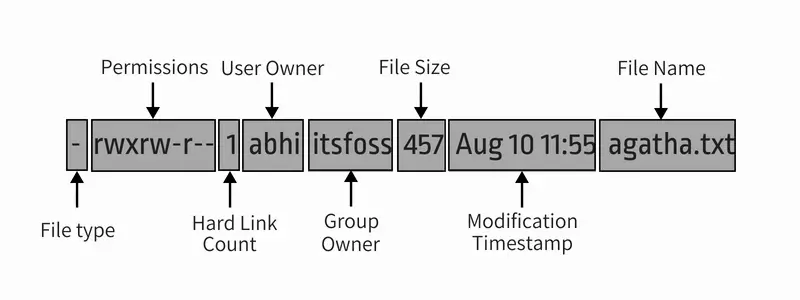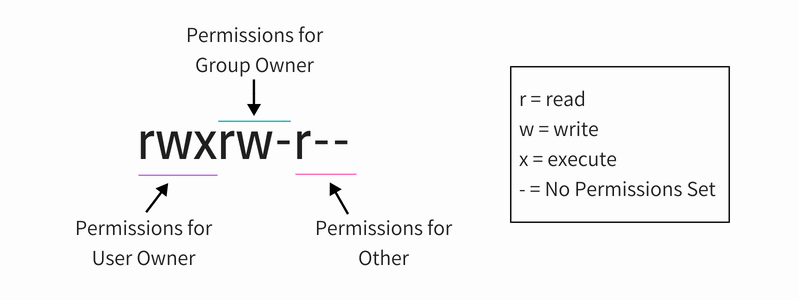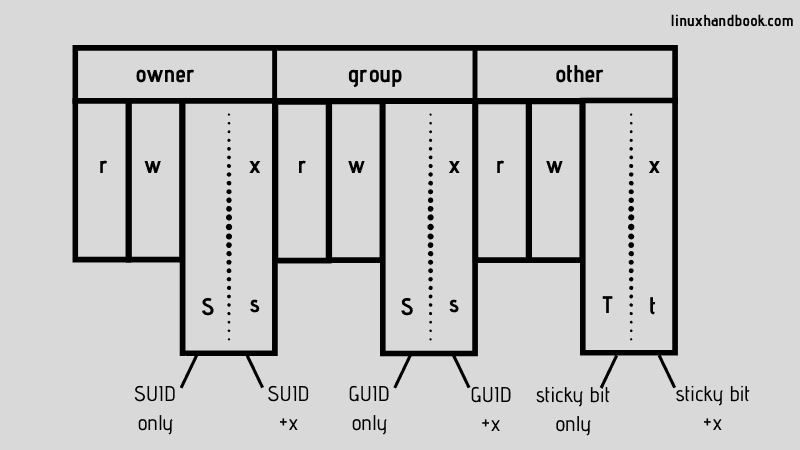How to Create New Files With Read Permissions in Websphere Application Server
By design, Linux is a multi-user operating system. In an enterprise system, at that place would exist multiple users accessing the same system. But if any user could access and modify all files belonging to other users or system files, this would certainly be a security take chances.
This is why UNIX and thus Linux (Linux is a Unix-like organisation) has built-in security measure in place. This ensures that a file or directory can be accessed, modified or executed by just desired users.
Which file would be accessed by which user is decided by ii factors in Linux:
- File ownership
- File permission
Agreement file ownership and permission is crucial for a Linux user. I'll explain these terms in detail here.
File ownership in Linux
Notation: I might use the term file here but it is applicable to directories too. I guess you know that directories are files anyhow.
Every file and directory in Linux has iii kinds of owners:
User
User is the possessor of the file. When y'all create a file, y'all get the possessor of the file. The buying can exist changed every bit well, but we'll see that subsequently.
Grouping
Every user is office of a certain group(s). A group consists of several users and this is one way to manage users in a multi-user environment.
For case, if you accept dev team, QA squad and sysadmin team accessing the same system, you should create separate groups for them. This way, you can manage files and security of the organisation finer. It saves time because instead of manually adding permission for each user, y'all tin merely add them to a group and alter the permission for the grouping. You lot'll come across how to do it later in this article.
Even if you are the but user of the organization, yous'll still be part of many groups. Distributions like Ubuntu also create a group with name same as the user'due south name.
💡
Run the command groups to see what user-groups you belong to.
Other
'Other' can be considered equally a super grouping with all the users on the arrangement. Basically, anyone with access to the system belongs to this group.
In other words, 'User' is a unmarried user, Group is a collection of users and Other consists of all the users on the system.
File permissions in Linux
Every file and directory in Linux has the following three permissions for all the 3 kinds of owners:
Permissions for files
- Read – Tin view or copy file contents
- Write – Tin can change file content
- Execute – Tin run the file (if its executable)
Permissions for directories
- Read – Can list all files and copy the files from directory
- Write – Can add or delete files into directory (needs execute permission as well)
- Execute – Tin enter the directory
Understanding file permissions and ownership in Linux
Now that you are enlightened of the basic terminology of file permissions and ownership, it's time to see it in activeness.
You can use the 'stat command' or the 'ls command' to check the file permissions.
If you utilize the ls command with option -l on a file, you'll see an output like this:
-rwxrw-r-- ane abhi itsfoss 457 Aug 10 11:55 agatha.txt Let me explain this output with a motion picture:

Let me further explain the entire output in detail:
- File type: Denotes the type of file. d means directory, – ways regular file, fifty means a symbolic link.
- Permissions: This field shows the permission prepare on a file. I'll explain it in detail in the next section.
- Hard link count: Shows if the file has hard links. Default count is i.
- User: The user who owns the files.
- Group: The group that has access to this file. Simply 1 grouping can be the owner of a file at a time.
- File size: Size of the file in bytes.
- Modification time: The engagement and time the file was concluding modified.
- Filename: Obviously, the name of the file or directory.
Now that you lot have understood the ls -fifty command output, let's focus on the file permission role.
In the above command, you run across the file permission like this in the nine digit format:
rwxrw-r-- Each letter denotes a item permission:
- r : Read permission
- w : Write permission
- 10 : Execute permission
- – : No permission set
Permissions are ever in the social club of read, write and execute, i.e., rwx. And then these permissions are fix for all 3 kind of owners (come across the buying section) in the order of User, Group and Other.
This picture will explicate things improve:

So, if you look at the above motion-picture show now, you can say the following things about the file permissions:
- The file has read, write and execute permissions for the User possessor. But who is this utilise owner of the file? Y'all have this info in the output of ls -l (i.e. user abhi).
- The file has read and write permissions for the Group but not execute. Which group is information technology? Yous take the grouping info in the output of the command ls -l (i.e. group itsfoss).
- The file has just read permission for Other i.e. everyone that has access to the system. You don't demand to know which other is it because 'other' ways all the users.
Now if you see the entire ls -l command once again, you can read the file permissions and ownership together.
-rwxrw-r-- i abhi itsfoss 457 Aug 10 xi:55 agatha.txt The file agatha.txt is owned by user abhi and abhi has read, write and execute permission. All the members of grouping istfoss take read and write access to this file while everyone else has only read admission to this file.
Notation: Root user has super powers and normally, it has read, write and execute permissions to all the files, even if you don't run into information technology in file permissions.
A single user may be the fellow member of several groups but only the primary grouping of the user is the group possessor of a file created past the user. The primary grouping of a user can exist institute using the id command like id -gn <username> . Exit the username blank if you lot are trying to notice your own chief group.
Now that you know how to detect out permissions on a file, let's come across how you can change the permission and ownership of a file.
Change file permissions in Linux
You lot can use chmod command for irresolute the permissions on a file in Linux.
📚
Permissions used to be called mode of access and hence chmod was the curt class of change the mode of admission .
At that place are 2 means to use the chmod command:
- Absolute style
- Symbolic mode
chmod 777 or 755? Learn to utilize chmod Command with Examples
This article will teach yous how to change permissions in Linux with applied examples of chmod command.

Using chmod in absolute mode
In the accented mode, permissions are represented in numeric grade (octal system to be precise). In this organization, each file permission is represented by a number.
- r (read) = iv
- w (write) = 2
- x (execute) = 1
- – (no permission) = 0
With these numeric values, y'all can combine them and thus one number can exist used to represent the unabridged permission set.
| Number | Permission |
|---|---|
| 0 | — |
| 1 | –10 |
| 2 | -due west- |
| 3 (i.e. two+1) | -wx |
| 4 | r– |
| five (i.e. 4+1) | r-x |
| half-dozen (i.e. four+2) | rw- |
| 7 (i.e. 4+2+ane) | rwx |
Can y'all estimate the file permission in numbers on agatha.txt file in our case so far? That's right, it'due south 764.
At present that you know what number represents which permission, let's meet how to modify file permission using this cognition.
Suppose you want to change the file permission on agatha.txt and so that everyone can read and write only no one tin execute it? In that case, you lot can employ the chmod command similar this:
chmod 666 agatha.txt If you lot list agatha.txt now, you'll run into that the permission has been inverse.
-rw-rw-rw- 1 abhishek abhishek 457 Aug x 11:55 agatha.txt Using chmod in symbolic mode
The problem with the accented style is that you should e'er provide three numbers for all the 3 owners even if you lot want to change the permission gear up for but one owner.
This is where you can utilise the symbolic mode with chmod command.
In symbolic mode, owners are denoted with the post-obit symbols:
- u = user owner
- g = group owner
- o = other
- a = all (user + group + other)
The symbolic mode uses mathematical operators to perform the permission changes:
- + for adding permissions
- – for removing permissions
- = for overriding existing permissions with new value
Now that you know let'south meet how to utilise chmod command in symbolic mode.
In our previous example, if you desire to add execute permission for group owner, you lot tin use chmod control like this:
chmod g+x agatha.txt If you look at the permissions on this file now, you'll encounter that execute permission has now been added:
-rw-rwxrw- 1 abhi itsfoss 457 Aug ten 11:55 agatha.txt Yous can besides combine multiple permission changes in one command. Suppose yous want to remove the read and write permission and add execute permissions for Other. You likewise want to add together execute permission for the User owner. You can do all of information technology ane unmarried command:
chmod o-rw+x,u+x agatha.txt The resulting permissions would exist like this:
-rwxrwx--x 1 abhi itsfoss 457 Aug 10 xi:55 agatha.txt If yous want to change the permissions for all three kinds of users at the same fourth dimension, you can utilize it in the following manner:
chmod a-10 agatha.txt This will remove the execute permission for anybody.
-rw-rw---- 1 abhi itsfoss 457 Aug 10 11:55 agatha.txt Some people discover converting the file permissions from one mode to another a deadening job. This why I created this little tool that allows yous to calculate Linux file permissions in diverse modes online.
Change file buying in Linux
To alter the buying of a file, y'all can use the command chown. Y'all may easily approximate that chown stands for alter owner.
You can change the user owner of a file in the following way:
chown <new_user_name> <filename> If you desire to alter the user besides as group, y'all can utilize chown control similar this:
chown <new_user_name>:<new_user_group> <filename> If you but want to change the group, you can either use chown command in this way:
chown :<new_user_group> <filename> or use chgrp command specifically used for changing group owner of a file or directory. You can guess that chgrp stands for modify group.
chgrp <new_user_group> <filename> In our instance so far, if you want to change the user owner and group to root, you tin use the chown command similar this:
sudo chown root:root agatha.txt This will alter the buying of the file to root for both user and the group.
-rw-rw---- 1 root root 457 Aug ten eleven:55 agatha.txt Notice that I had to use sudo with chown? It's because the root is involved hither and to deal with root, you demand superuser rights.
Tip: 2 groups cannot own the same file.
Bonus Tip: Is at that place a precedence in file permissions?
Think of a situation, where the user owner doesn't accept any permissions, group has read permission while others take read and write permissions.
----r--rw- 1 abhi itsfoss 457 Aug 10 eleven:55 agatha.txt Now, if the user abhi tries to read the file using cat or less command, volition he be able to? The respond is no because it doesn't have the read permission.
But user abhi is part of group itsfoss and the group has read access. Heck! other has read and write permission. This should hateful that anybody (including user abhi) can read and write the file, correct? Incorrect!
In Linux, the precedence takes from user and so grouping and and then to other. Linux system checks who initiated the process (true cat or less in our instance). If the user who initiated the process is also the user owner of the file, the user permission bits are set.
If the owner of the file didn't initiate the process, and so the Linux organisation checks the group. If the user who initiated the process is in the same group as the possessor group of the file, group permissions bit are set.
If this process possessor is non even in the group as the file's group owner, so the other permission bits are set.
What is SUID, GUID and Sticky Bit in Linux? How to Use Them?
Y'all see an s instead of x in the file permissions? Linux has some special file permissions chosen SUID, GUID and Sticky Bit. Know more about them.

What side by side?
I hope you liked the article and now you have a better agreement of how file permissions work in Linux.
There are some advanced file permissions like SUID, GUID and sticky bit that you may larn next, if you lot want to.
If yous have any questions or suggestions or if you lot just desire to say thanks, please leave a comment beneath. If you liked the article, please share it on social media or various forums. This will help us and other Linux users likewise.
Source: https://linuxhandbook.com/linux-file-permissions/
0 Response to "How to Create New Files With Read Permissions in Websphere Application Server"
Post a Comment